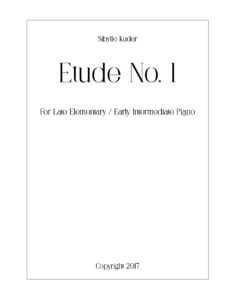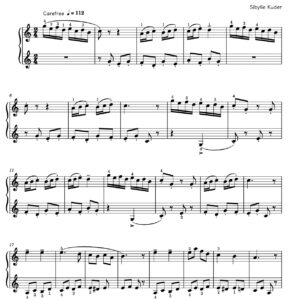 .
.
This teaching piece has no dynamic markings which does not mean that dynamics are not important. Rather, it is intentionally left up to the teacher to explore dynamics along with the student.
Earlier level students may do better with just one dynamic mark that perhaps changes every other line whereas a more experienced student could handle subtle and gradual dynamic changes within each phrase.
The title “Etude” could (should!) be replaced with a more imaginative, descriptive title – another opportunity for the teacher to engage the student’s imagination and musical thinking.
The form of this piece is A – A1 – B – bridge – A1 – A2
The A sections move faster, with sixteenth notes in the right hand, and left hand staccato eighth notes. The middle section is lyrical, legato, and – without sixteenth notes – seems to move more slowly. It has an interesting modulation from A minor to F major which could invite a discussion about key relationships.
Found throughout the etude are the following opportunities to work on technical skills:
-
broken thirds, moving step-wise up or down, such as are found in Clementi Op. 36 No 1, to work on wrist rotation
-
staccato or tenuto longer note values in one hand against legato shorter note values in the other, a common feature in baroque piano music
-
three-note gestures, always in the right hand, all but one with fingers 1-2-3, to work on drop-and-lift gestures
Additionally, the lyrical middle section requires a more expressive touch, and horizontal thinking to keep the melody moving forward.
